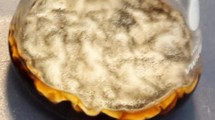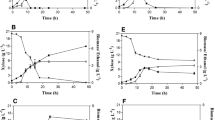Abstract
Byssochlamys fulva AM130, a novel strain of filamentous fungus, could produce ethanol from glucose, xylose, and alkali pretreated rice straw (PRS), while the efficiencies were very low with PRS. Ethanol production of 11.84 g/L was attained by the fungus when grown in glucose, indicating that the limitations while growing on PRS were related to low hydrolytic efficiency. Enzyme profiling of the fungus showed 365 IU/ml of beta-glucosidase and 89 IU/ml of xylanase activity, while endoglucanase and filter paper activity were negligible, which accounts for the low hydrolytic efficiency. The fungus could survive for extended periods under oxygen-limited conditions and produce ethanol. The fungal mycelia could also be used for repeated cycles of anaerobic fermentation, wherein the ethanol yield improved with each consecutive cycle.






Similar content being viewed by others
References
Ali S, Nugent B, Mullins E, Doohan FM. Fungal-mediated consolidated bioprocessing: the potential of Fusarium oxysporum for the lignocellulosic ethanol industry. AMB Expr. 2016;6:13. https://doi.org/10.1186/s13568-016-0185-0.
Amore A, Faraco V. Potential of fungi as category I consolidated bioprocessing organisms for cellulosic ethanol production. Renew Sustain Ener Rev. 2012;16(5):3286–301.
Anasontzis GE, Christakopoulos P. Challenges in ethanol production with Fusarium oxysporum through consolidated bioprocessing. Bioengineered. 2014;5(6):393–5. https://doi.org/10.4161/bioe.36328.
Bailey MJ, Biely P, Poutanen K. Inter-laboratory testing of methods for assay of xylanase activity. J Biotechnol. 1992;23:257–70.
Bonaccorsi ED, Ferreira AJS, Chambergo FS, Ramos ASP, Mantovani MC, Simon Farah JP, Sorio CS, Gombert AK, Tonso A, El-Dorry H. Transcriptional response of the obligatory aerobe Trichoderma reesei to hypoxia and transient anoxia: implications for energy production and survival in the absence of oxygen. Biochemistry. 2006;45:3912–24.
Ghose TK. Measurement of Cellulase activities. Pure & Appl Chem. 1987;59(2):257–68.
Horisawa H, Inoue A, Yamanaka Y. Direct ethanol production from lignocellulosic materials by mixed culture of wood rot fungi Schizophyllum commune. Bjerkandera adusta Fomitopsis palustris Fermentation. 2019;5:21. https://doi.org/10.3390/fermentation5010021.
Kashid M, Ghosalkar A. Critical factors affecting ethanol production by immobilized Pichia stipitis using corn cob hydrolysate. Prep Biochem Biotechnol. 2018;48(3):288–95.
Kotzekidou P (2014) Byssochlamys. In: Batt CA, Tortorello ML (eds) Encyclopedia of Food Microbiology (Second Edition), Academic Press, London, pp 344–350. https://doi.org/10.1016/B978–0–12–384730–0.00051–3
Kruckeberg AL, Dickinson JR. Carbon metabolism. In: Dickinson JR, Schweizer M, editors. The metabolism and molecular physiology of Saccharomyces cerevisiae. London: CRC; 2004. p. 42–103.
Losordo Z, McBride J, Van Rooyen J, Wenger K, Willies D, Froehlich A, Macedo I, Lynd L. Cost competitive second-generation ethanol production from hemicellulose in a Brazilian sugarcane biorefinery. Biofuels Bioprod Bioref 2016; 10:589–602.
Mandels M, Weber J. The production of cellulases. Adv Chem Ser. 1969;95:391–413.
Mathew A. Studies on glucose tolerant beta-glucosidases from a novel Byssochlamys fulva and their applications in biomass to ethanol conversion (Doctoral Thesis), Cochin University of Science and Technology, Kochi, Kerala, India. 2011; https://hdl.handle.net/10603/19159
Meena S, Navatha S, Prabhavathi Devi BLA, Prasad RBN, Pandey A, Sukumaran RK. Evaluation of Amberlyst15 for hydrolysis of alkali pretreated rice straw and fermentauon to ethanol. Biochem Eng J. 2015;102:49–53.
Millati R, Edebo L, Taherzadeh MJ. Performance of Rhizopus, Rhizomucor, and Mucor in ethanol production from glucose, xylose, and wood hydrolyzates. Enzyme Microb Technol. 2005;36:294–300.
Miller GM. Use of dinitrosalicylic acid reagent for determination of reducing sugar. Anal Chem. 1959;31:426–8.
Nair RB, Kabir MM, Lennartsson PR, Taherzadeh MJ, Horvath IS. Integrated process for ethanol, biogas, and edible filamentous fungi-based animal feed production from dilute phosphoric acid-pretreated wheat. Appl Biochem Biotechnol. 2018;184:48–62.
Nair RB, Osadolor OA, Ravula VK, Lennartsson PR, Taherzadeh MJ. Lignocellulose integration to 1G-ethanol process using filamentous fungi: fermentation prospects of edible strain of Neurospora intermedia. BMC Biotechnol. 2018;18:49. https://doi.org/10.1186/s12896-018-0444-z.
Panagiotou G, Christakopoulos P, Olsson L. Simultaneous saccharification and fermentation of cellulose by Fusarium oxysporum F3–growth characteristics and metabolite profiling. Enz Microb Technol. 2005;36:693–9.
Panagiotou G, Villas-Bôas SG, Christakopoulos P, Nielsen J, Olsson L. Intracellular metabolite profiling of Fusarium oxysporum converting glucose to ethanol. J Biotechnol. 2005;115(4):425–34.
Singh A, Kumar PKR. Fusarium oxysporum: Status in Bioethanol Production. Crit Rev Biotech. 1991;11(2):129–47.
Skory CD, Freer S, Bothast RJ. Screening for ethanol -producing filamentous fungi. Biotech Lett. 1997;19(3):203–6.
Sluiter A, Hames B, Ruiz R, Scarlata C, Sluiter J, Templeton D. Determination of sugars, Byproducts, and Degradation Products in Liquid Fraction Process Samples. Technical report NREL/TP-510–42623. 2006; https://www.nrel.gov/docs/gen/fy08/42623.pdf.
Zhang GC, Liu JJ, Kong IL, Kwak S, Jin YS. Combining C6 and C5 sugar metabolism for enhancing microbial bioconversion. Curr Opin Chem Biol. 2015;29:49–57.
Acknowledgements
The authors are thankful to the Council of Scientific and Industrial Research (CSIR) for the financial support for the project MLP 0035 (33/2018/MD-FTT&FTC-ANB) of which this study forms a part of. PKV would like to thank CSIR for providing research fellowship for his Ph.D. work. The authors declare that they do not have any conflict of interest.
Author information
Authors and Affiliations
Corresponding author
Rights and permissions
About this article
Cite this article
Krishnamoorthy, J., Mathew, A., Kooloth-Valappil, P. et al. Ethanol production by a filamentous fungal strain Byssochlamys fulva AM130 under alternating aerobic and oxygen-limited conditions. Syst Microbiol and Biomanuf 1, 111–121 (2021). https://doi.org/10.1007/s43393-020-00010-y
Received:
Revised:
Accepted:
Published:
Issue Date:
DOI: https://doi.org/10.1007/s43393-020-00010-y




